Japanese
English
- 有料閲覧
- Abstract 文献概要
- 1ページ目 Look Inside
- 参考文献 Reference
2019年12月に中国・武漢で初めて報告された新型コロナウイルス(SARS-CoV-2)による感染症であるCOVID-19は急速に世界中に拡大した。COVID-19に関連するギラン・バレー症候群の大多数は脱髄型であり,感染後の免疫応答が発症機序と想定されている。また,COVID-19患者では筋痛やCK値上昇といった筋障害が比較的多くみられ,一部の患者に筋炎が生じることがある。筋障害の機序としてはSARS-CoV-2による直接的な障害やⅠ型インターフェロノパチーが考えられている。
Abstract
Severe acute respiratory syndrome coronavirus 2 (SARS-CoV-2) and its associated coronavirus disease (COVID-19) were reported to originate from Wuhan, China, in December 2019, spreading rapidly worldwide. With the emergence of this pandemic, an increasing number of cases of Guillain-Barré syndrome (GBS) have been reported following this infection. Most patients had a demyelinating subtype of GBS. The time interval between infectious and neuropathic symptoms, absence of cerebrospinal fluid pleocytosis, and negative polymerase chain reaction test result support a postinfectious mechanism. Skeletal muscle injury presents as muscle pain and elevated serum creatine kinase level in patients with COVID-19. Some patients developed several myopathic manifestations, including new-onset inflammatory myopathy. Muscle injury is caused by direct SARS-CoV-2 infection or through parainfectious mechanisms such as type I interferonopathy.

Copyright © 2022, Igaku-Shoin Ltd. All rights reserved.


